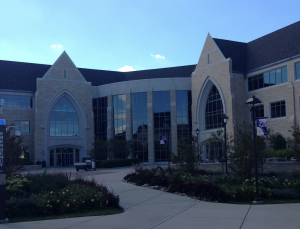Solar panel installation began Monday, Sept. 22 on the roof of the Anderson Student Center after years of work from St. Thomas’ Sustainability Committee.
According to the ASC Solar Panel Project Summary, the 3,692-square-foot unit installation by Cedar Creek Energy will take three weeks. The panels were created by tenKsolar, a Minnesota solar panel development and manufacturing company. The project’s proposal said the panels will cost $144,320.
Bob Douglas, central receiving chair of the Sustainability Committee, said this is St. Thomas’ third attempt at having the panels installed on the student center.
“We made two other attempts to get the panels put on, but what happened was we were working with a different company and we just couldn’t get the finances together,” Douglas said.
The Campus Sustainability Fund is financing $50,571 of the project, according to its website. The Made in Minnesota Solar Energy Program lottery provides a rebate around $11,200 per year based on how much energy is generated to finance the rest of the project.

Physical Plant administrator Jim Brummer created the ASC Solar Panel Project Summary and said the university is relying on the yearly rebate, and Douglas said the project should be paid off in the next three to four years.
The proposal for the current project, which was submitted in the spring, listed three university roofs in the Made in Minnesota Solar Energy Program lottery – the student center, the Anderson Athletic and Recreation Complex and the McCarthy Gymnasium – but only the student center project was financed. Different organizations can apply for the lottery and a few get selected for financing.
“This (project) is the largest thing that has been funded by the Campus Sustainability Fund,” Douglas said.
Solar panels are a long-term investment, according to Douglas. The proposal said the panels are guaranteed to produce energy for 25 years but are expected to last longer. During this time period, the panels are estimated to cut the St. Paul campus’ energy costs by $5,100 per year. With costs of other forms of energy likely to increase over the panels’ lifetime, the value and the amount of money they save the university will also increase.
“These panels are supposed to be the cutting edge right now, and they keep improving,” Douglas said.
According to the project summary, early estimates predict that this system will offset 46 tons of carbon emissions per year and 1,120 tons in the 25-year life expectancy. However, the panels’ exact energy production cannot be immediately determined.
“It’s not enough to power the whole building. This is a very energy-intense building, but it will significantly reduce the load,” Douglas said. “It will be interesting to see how much it is able to do that.”
Freshman Owen Nowick said he was excited about the addition of solar panels.
“I think the more use of solar power, the better,” Nowick said. “It would be great to see (campus) more green and more prepared for the future.”
The proposal said several classes, including some from the environmental studies, engineering and biology departments, were interested in making the solar panels part of their curriculum.
With the proposal’s approval, Douglas said students would get a chance to go up on the roof to see how the panels are arranged and interpret data about energy generation and consumption.
“To be able to teach classes that deal with sustainability issues: How do we keep going? How do we keep our culture going? How do we keep making decisions that won’t destroy it for the next generation?” Douglas said. “That should be a topic in the classroom.”
Senior Kelsey Long said she thought that incorporating sustainability topics into the classroom is beneficial.
“I feel like there are still some people who don’t realize how big of an issue it is and aren’t really seeking out information,” Long said. “So bringing it into the classroom and making it something that you have to talk about makes it more real and brings more information to more people.”
The student center panels face Cretin Avenue but aren’t visible from the street because the campus is located in a heritage district of St. Paul, which requires preservation of historical elements, such as building design, Douglas said.
The Environmental Protection Agency ranked St. Thomas No. 21 in top colleges and universities for using green power this summer.
Junior Winnie Cooley said she likes the St. Thomas’ environmental efforts so far and anticipates more for the future.
“I think we’re making a lot of progress each year. You can see the changes,” Cooley said.
Lauren Smith can be reached at smit7607@stthomas.edu.

